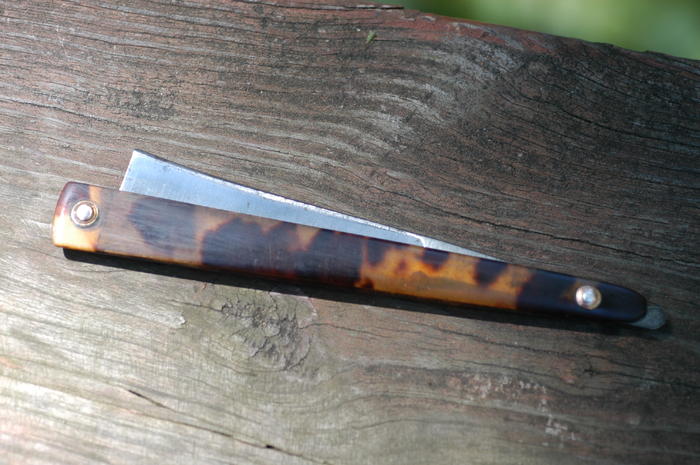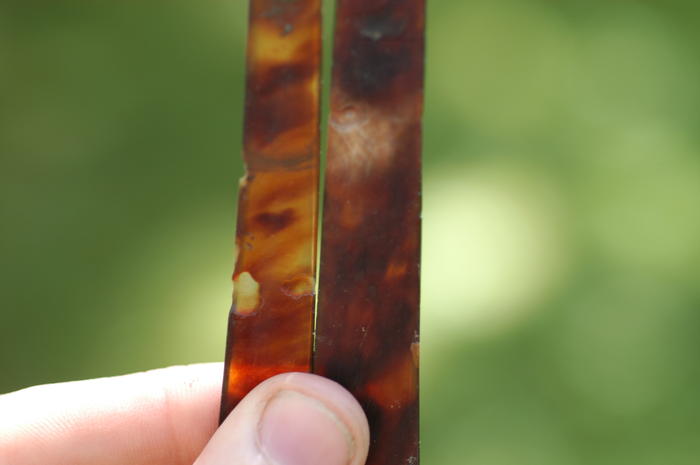Results 21 to 30 of 31
-
05-18-2013, 03:12 AM #21

Gonna take while to read thru this, But, THANKS, ScienceGuy, for providing this! And thanks to all the contributors as well.
Great thread! "Don't be stubborn. You are missing out."
"Don't be stubborn. You are missing out."
I rest my case.
-
05-18-2013, 03:31 AM #22

Bingo. This one is dyed horn, for all the reasons you guys found. The edges are sharp, the colors are a little off, and the dark colors don't penetrate. It is also late English and has collars (though it has been restored so hard to say on that point). Once you've seen a good amount of the dyed horn, even good ones like this jump out right away as faux. Good eyes!
-
05-18-2013, 03:36 AM #23
-
05-25-2013, 03:35 PM #24

Ok here's some more tortoise.
A good early example with a lot of blonde parts. This type is my favorite:

Next up, I picked this up from razor emporium for super cheap. (It was listed as celluloid... heh...). You can even see the bug bites in the original photo from the listing.

These scales were too far structurally damaged to be used whole, so I put them to use in another project. Anyway, here's a bunch of pictures for reference of what the material looks like in various lighting conditions. These were also very matte from years of neglect.





-
12-25-2014, 10:29 PM #25Historically Inquisitive



- Join Date
- Aug 2011
- Location
- Upstate New York
- Posts
- 5,782
- Blog Entries
- 1
Thanked: 4249
Link to interesting pdf of The Characterization of Tortoise Shell and its Imitations The Characterization of Tortoise Shell and its Imitations | Gems & Gemology
-
The Following 5 Users Say Thank You to Martin103 For This Useful Post:
engine46 (09-14-2015), JimmyHAD (12-26-2014), MikeT (07-03-2016), ScienceGuy (12-26-2014), Wullie (12-26-2014)
-
09-12-2015, 12:45 PM #26

Here is a French late 18th C. or early 19th C. razor
with silver washers, shield and VERY thin darkened tortoise scales (small bug bites are visible)





Last edited by Fikira; 09-12-2015 at 07:24 PM.
-
09-13-2015, 07:45 PM #27

Here is an additional photo showing the variations in coloring that can be obtained. The material doesn't darken substantially with age - these are all about the same age. The coloring comes from natural variations, and variations when the scutes are pressed together into thicker material.

-
The Following User Says Thank You to ScienceGuy For This Useful Post:
Fikira (09-13-2015)
-
09-14-2015, 01:18 AM #28

This has been a very interesting read. A big thanks to all!
-
07-03-2019, 09:44 PM #29Junior Member

- Join Date
- Jul 2019
- Posts
- 1
Thanked: 0
This is extremely helpful information. My non-profit is working on end the illegal tortoiseshell trade and I was hoping to get in touch with the author. If they can email me at brad at seeturtles.org, I would really appreciate it.
-
07-03-2019, 10:07 PM #30

A 6 year old post.
I don't think he is active here anymore.No matter how many men you kill you can't kill your successor-Emperor Nero


 93Likes
93Likes LinkBack URL
LinkBack URL About LinkBacks
About LinkBacks






 Reply With Quote
Reply With Quote






